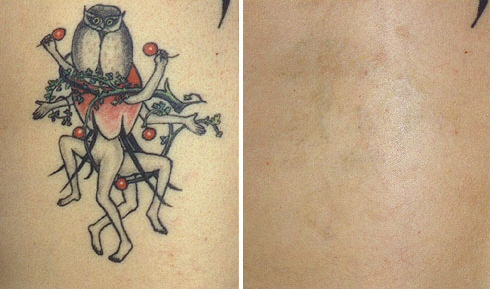Removal of dark and coloured tattoos without scarring
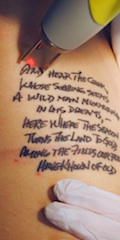 The once desired and proudly worn tattoos might become disturbing for their owners. Tattoo removal is not an easy procedure as it always requires laser technology and professional skills. Thanks to state-of-the-art laser technology, nowadays dermatologists are also capable of removing tattoos of any colour without scarring.
The once desired and proudly worn tattoos might become disturbing for their owners. Tattoo removal is not an easy procedure as it always requires laser technology and professional skills. Thanks to state-of-the-art laser technology, nowadays dermatologists are also capable of removing tattoos of any colour without scarring.
During the past decade, the demand for tattoo removal has boosted. Several reports and studies indicate that laser tattoo removal is one of the most dynamically emerging procedures in the practice of cosmetic professionals.
How is laser tattoo removal performed?
Laser tattoo removal is the only clinically proven method of tattoo removal without scarring. Q-switched lasers are designed in such a way that their pulsed output beams break down tattoo pigments.
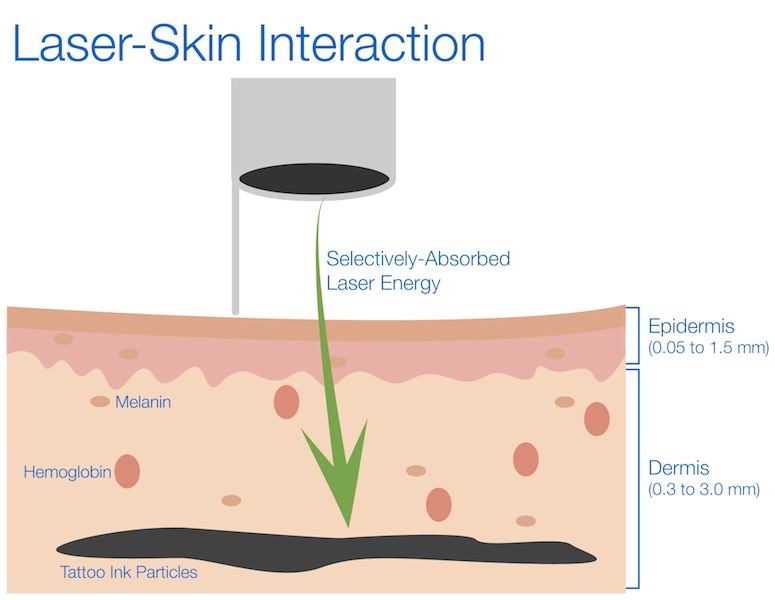
In the course of tattoo removal, the tattooed area is exposed to laser light. Laser light is selectively absorbed by tattoo pigments, and those pigments are shattered to smaller pieces. The smaller pigment particles can be ingested by phagocytes; eventually, the pigments are gradually excreted from the body. The equipment emits rapid pulses of light, the energy of which heats tattoo pigments so quickly that those are shattered to pieces before the surrounding skin would be heated too much; with this method, scarring can be prevented and the surrounding epidermis remains intact.
Following laser tattoo removal, the immune system ejects the shattered pigments, so the tattoo will fade away.
Indications of tattoo removal
There are several reasons why somebody might want to get rid of their permanent tattoos. As the treatment requires time and money, patients are usually quite motivated to have their tattoos removed, and they tend to be happy with the results.
The most frequent motivations to remove tattoos are the following:
- The tattoo cannot be covered easily (restricted dressing opportunities)
- The tattoo hinders the acceptance of the patient, e.g. at work
- The tattoo was badly made
- The tattoo bears the name of an ex-partner
- The tattoo has faded over time
How many visits are necessary to remove a tattoo completely?
Tattoos are removed in several steps at several visits. First, the laser beam takes effect in the surface pigment layer which takes 2-3 weeks to disappear. Afterwards, a subsequent treatment can be performed: now the laser beam goes deeper and the previous process is repeated (i.e. the processed pigment takes a few weeks to disappear).
The location of treatment is applied with an anaesthetic gel (30% lidocaine gel), so the treatment is almost completely painless.
The treatment should be repeated until the pigment completely disappears from the skin. After subsequent treatments, the tattoo becomes increasingly lighter and gradually disappears.
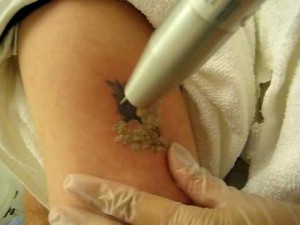
The laser treatment should usually be repeated once a month. Permanent tattoo removal usually requires 4-8 visits, although more treatments might be necessary in the case of coloured tattoos.
The number of treatments depends on several factors: the quality of ink, the amount of ink applied to the skin, the depth of the tattoo, and the quality of the skin.
A treatment takes about 10-30 minutes.
It is recommended to avoid sun tanning or tanning beds for at least two weeks before the laser treatment.
Examples of tattoo removal
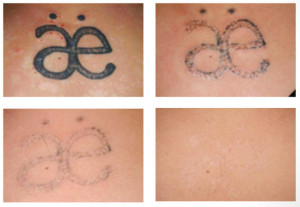
What kind of adverse effects can occur after the treatment?
The location of treatment might be slightly swollen and become lighter immediately after the treatment. For 30 minutes following the treatment, an ice pack should be placed on the affected location.
Adverse effects might include swelling, itch, blisters, scabs, flushing, hyper-pigmentation, or hypo-pigmentation. These effects are usually temporary and pass in a few days.
What should patients do after the laser treatment?
On the day after the treatment, the usual cosmetics can be used. The temporary differences in colour can be hidden with primers and cream powders. Patients should avoid sun tanning or tanning beds after the treatments. At the location of treatment, the skin will peel off. After the treatment, it is recommended to use Panthenol or other products intended for the treatment of sunburns.
